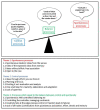Complex cognition and individual variability: a mixed methods study of the relationship between creativity and executive control
- PMID: 37425186
- PMCID: PMC10323225
- DOI: 10.3389/fpsyg.2023.1191893
Complex cognition and individual variability: a mixed methods study of the relationship between creativity and executive control
Abstract
One of the methodological challenges of educational neuroscience is understanding real world cognition in the multifaceted environment of the classroom. Complex cognition does not simplify to processes (which might be satisfactorily measured in the lab) but to sets of activities, likely to vary between individuals, which involve the iterative use of multiple processes, as well as the environment, over an extended period of time. As such, studying complex cognition requires methodological flexibility; any single method is unlikely to provide complete answers. We illustrate this idea with our research exploring the relationship between executive control (EC) and creativity in primary school age children; in it, we used both qualitative and quantitative tools and a novel approach to bringing both sets of findings together. Quantitative findings helped inform 'how much' a participant could deploy EC or creative thinking, while qualitative findings told us more about 'how' they deployed EC in their creativity. Through triangulating findings, we gained insights which would have remained obscure using either approach alone; namely, first, that wide variation in how children deploy EC in creativity means that the same creative results can be achieved with very different levels of EC involvement, and second, that high levels of EC can limit creativity. We argue that, beyond the specific findings of this study, there might be useful broader methodological lessons for educational neuroscience. We also attempt to demystify mixed methods by showing that a multi-pronged approach is more feasible than many assume; for example, by using existing, familiar tools in novel ways. In our work, we redeployed well-established quantitative tests used in creativity research as stimuli for qualitative investigation. For educational neuroscience to evolve its understanding of complex cognition, we suggest it might benefit from being innovative, open-minded and ambitious in how it exploits the diversity of methodological tools available.
Keywords: creativity; executive control; methodology; mixed methods; qualitative; quantitative; triangulation.
Copyright © 2023 Rogers, Tolmie, Massonnié and Thomas.
Conflict of interest statement
The authors declare that the research was conducted in the absence of any commercial or financial relationships that could be construed as a potential conflict of interest.
Figures






References
-
- Abraham A. (2018). The neuroscience of creativity Cambridge UK: Cambridge University Press.
-
- Amabile T. M., Pillemer J. (2012). Perspectives on the social psychology of creativity. J. Creat. Behav. 46, 3–15. doi: 10.1002/jocb.001 - DOI
-
- Anwyl-Irvine A., Dalmaijer E., Hodges N., Evershed J. (2020). Online timing accuracy and precision: a comparison of platforms, browsers, and participant’s devices. Psy ArXiv. doi: 10.31234/osf.io/jfeca - DOI
LinkOut - more resources
Full Text Sources
Research Materials
Miscellaneous

